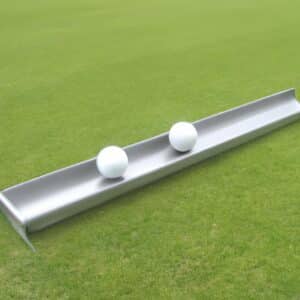Last Updated on June 9, 2023
Have you ever wondered what golfers are doing when they measure the speed of a putting green with an odd-looking metal device? That object is known as a Stimpmeter, which plays an important role in helping golfers get the most out of their game. The Stimpmeter has been used throughout history to ensure that players experience an accurate and fair round on the course. So, what exactly is a Stimpmeter, and how does it work? Let’s find out!
The term “stimp” comes from the name Stimpson, which was given to the inventor of this popular measuring tool for putting greens. A Stimpmeter measures the speed of a golf ball rolling over turf by determining its distance travelled relative to time. It’s designed so that readings taken at different locations across a green can be compared reliably. This helps give golfers an understanding of how quickly or slowly balls roll on any given surface, allowing them to adjust their strategies accordingly.
Golf courses use Stimpmeters to keep track of how well grass grows on greens, sand traps, and other areas around the course. Knowing this information allows groundskeepers to maintain optimum playing conditions that benefit both professional and amateur golfers alike. In addition, tournaments often require courses to meet strict guidelines regarding ball speeds before events begin – something made possible thanks to these incredible devices!
Design and Construction of a Stimpmeter
A Stimpmeter is a device used in golf to measure the speed of greens. It’s designed and built by hand, which requires careful attention to detail and accuracy. Building a Stimpmeter involves cutting two pieces of wood into equal lengths so that they fit together snugly when laid side-by-side. The edges at each end must be perfectly straight for the meter to work properly. Once these pieces are cut, holes need to be drilled down the centre of both boards precisely, allowing them to slide against one another smoothly during use. For extra durability and strength, metal strips may also be added along the sides of the wooden boards before they’re joined together permanently. After creating the frame, a rubber band should be looped around it in order to hold it taut while taking measurements on different surfaces. This simple yet effective tool can easily be constructed using everyday materials found in most households or workshops.
How to Use a Stimpmeter

Using a Stimpmeter is an essential part of golf course maintenance, as it helps to measure the speed and consistency of the green. There are some important steps for using a Stimpmeter accurately. First, you need to adjust your line so that the ball will go straight at least five yards down the target line you intend to use. Then, place the Stimpmeter on flat ground near the back edge of where you want your putt to start from. You must make sure that it’s oriented in such a way that when you roll the ball over it, it won’t be affected by any bumps or slopes.
After that, drop three balls onto each end of the Stimpmeter with enough force so that they’ll roll straight down its length. Measure how far each ball rolls and then average out those results; this value will give you an indication of how fast your green is running at that particular spot. Finally, make adjustments accordingly if needed to ensure accuracy and repeat these steps until all areas have been measured properly.
Factors Affecting the Readings From a Stimpmeter
Now that we know how to use a Stimpmeter to measure the speed of greens, let’s look at some factors that can affect its accuracy.
- Environmental conditions such as wind and temperature
- Ground surfaces such as wetness or dryness
- Weather conditions like rain or fog
All these elements play an important role in determining the readings from a Stimpmeter. The more consistent they are, the more accurate your results will be. For example, if you take two readings on different days with variable weather conditions, then the reading will not be reliable. Similarly, the ground surface must remain stable throughout for consistent results. If a golfer changes between putting on damp and dry surfaces during testing, then it could affect the outcome significantly. It is also important to note that any debris or obstructions near the hole may have an adverse effect on the accuracy of Stimpmeter readings.
Therefore, when using a Stimpmeter to test green speeds, always make sure environmental conditions, ground surface and weather conditions are taken into consideration so that your measurements are correct and reliable.
Scientific Basis of the Stimpmeter

A Stimpmeter is a device used to measure the speed of a golf ball’s roll on a putting green. It is designed to provide an estimate of the speed of play in relation to other players and courses, as well as serve as a means for comparison between greens. The basis behind its use involves calculating the coefficient of friction between the golf ball and the turf surface. When rolled down an inclined ramp with consistent force, it measures how far it travels over two feet or more, allowing for the calculation of velocity. This number gives us what is known as ‘green speed’ – an indication of how fast a putt will travel when struck from any part of that particular green.
It also serves as an important tool for turf managers and groundskeepers responsible for establishing uniformity across their respective courses by providing accurate feedback regarding potential issues such as mowing heights, rolling techniques, and even fertiliser application rates which could all affect playing conditions. Having access to this information can help them make better decisions about upkeep and maintenance practices while ensuring optimal performance out on the links.
Alternatives to the Stimpmeter
In contrast to the Stimpmeter, there are a variety of alternative measuring devices available for golf putting green speed. Golfers can use stimp-reading calculators that measure ball roll distance and calculate the average speed of the green. Additionally, they may also opt for a golf green speed test which is usually completed by driving a ball across the surface at different distances from various angles. Moreover, those who play on artificial turf may consider getting an artificial turf speed measurement device in order to determine how fast their course is running.
These alternatives offer players more accurate readings than traditional manual methods such as eyeballing or hand-rolling balls down fairways. Furthermore, these measurements can help inform decisions about what clubs to choose when playing certain courses or even improve one’s overall game. With all these options available, golfers have multiple tools at their disposal with which to accurately measure their course’s speeds and adjust accordingly.
Frequently Asked Questions
What Is the Average Reading From a Stimpmeter?
The average stimp measurement should be between 8-12 feet per second (fps). This range allows players to make accurate adjustments in their strokes while providing enough resistance so they’re not hitting too far off-line or overshooting putts. Stimp readings are essential when playing golf as it helps inform players about what type of stroke they should use depending on the conditions of the day. A high stimp reading requires more precision and finesse, whereas lower readings allow for more power behind your shots. Knowing your course’s stimp rating will give you an advantage during play, as you’ll know exactly how hard or soft you need to hit each shot.
Conclusion
In conclusion, the Stimpmeter is an important tool for measuring and improving golf course conditions. It provides a reliable standard of measurement that can be used to set performance standards on any type of golf course. When using a Stimpmeter, it’s important to keep in mind there may be health or safety concerns associated with its use. Finally, Stimpmeters should be recalibrated at least once per year to ensure accuracy when taking readings. Overall, the Stimpmeter is an invaluable tool for golfers looking to improve their game by understanding how different courses play differently.



